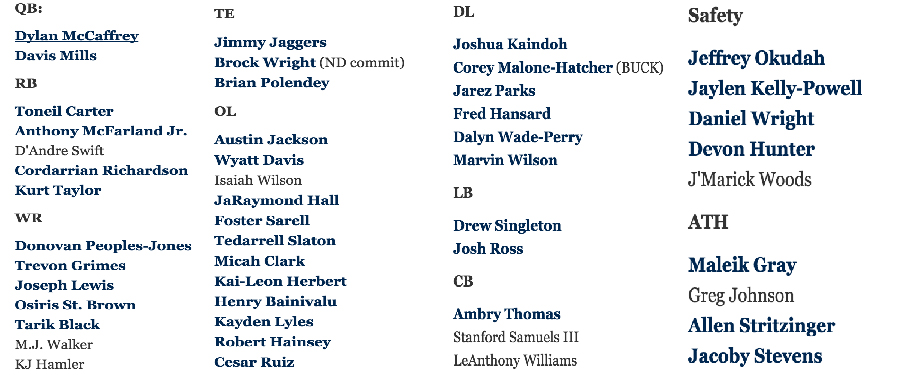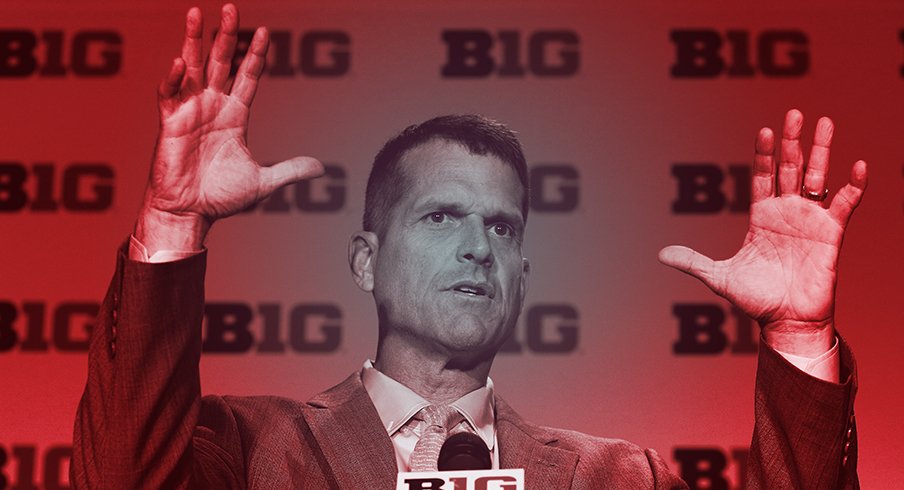The names are etched into the lore of college football's greatest rivalry. They are the young men who defied their birthright, defied their homes and became enemies of their state.
Desmond Howard and Charles Woodson are two that stand out, but there's hundreds throughout history that have cast aside their Buckeye roots for the chance to wear Maize and Blue; hundreds who have sworn off their heritage and effectively exiled themselves from all they knew and loved.
Ok – perhaps I'm going over the edge a bit – but seriously there have been a lot of Ohio kids over the years that have chosen Michigan. Some had the chance to be Buckeyes, most did not and that chip on their shoulder carried them to successful Wolverine careers. They are the names that have, in some cases, helped define the rivalry, especially for recent generations.
Bo Schembechler recruited Ohio, Gary Moeller recruited Ohio, Lloyd Carr recruited Ohio and Brady Hoke recruited the heck out of Ohio.
So why is Jim Harbaugh avoiding it?
As of today, Michigan's 2016 recruiting class – Harbaugh's first full class at Michigan – is doing very well. The Wolverines are ranked as the country's eighth-best class, and the third in a resurgent Big Ten. Harbaugh's staff has pounded the pavement nationally and has verbal commitments from prospects from:
- Alabama (2)
- California (1)
- Florida (4)
- Illinois (1)
- Indiana (3)
- Maryland (3)
- Massachusetts (1)
- Michigan (3)
- New Jersey (3)
- Wisconsin (1)
- Canada (1)
23 commitments and not one from Ohio. The last time that happened was 2007, when Michigan's class was transitioning from Lloyd Carr to Rich Rodriguez. Harbaugh knows the value of the rivalry, the passion and hatred of it better than most, so what gives? I reached out to Steve Lorenz from the 247Sports.com network and got his thoughts.
"I have wondered the same thing," Lorenz said about the decision to leave Ohio alone. "I think the biggest thing (at least with 2016 and even 2017) is that Ohio State is on such a high right now that they're going to get the total pick of the litter when it comes to those elite Ohio prospects and that in a lot of cases it's not worth Michigan's resources to pursue players that are going to choose Ohio State. It's the only logical reason they haven't been overly aggressive (yet) in the 2017 class, where there are a few types (Danny Davis, Javonte Richardson) that could be Michigan types if they were to offer first and pursue aggressively, especially when you consider how well Ohio State will continue to do nationally."
On September 1st, as the Wolverine coaching staff was able to finally reach out to 2017 stars across the country, Lorenz and his staff chronicled their efforts and again, there was a glaring omission: not a single prospect from Ohio.

Ohio State has commitments in their 2017 class from five of Ohio's top 10 talents in 2017 and the presumed leader for Cleveland's Jaylen Harris, who they've offered, as well. The aforementioned Richardson and Davis are seventh and eighth in the state respectively and although neither has a Buckeye offer – and at this point aren't necessarily close to receiving one – Michigan continues to stay away. Michigan State and Kentucky have picked up the pace in Ohio while the Wolverines have turned their attention elsewhere. Lorenz says that in time, and with more on-field success, Michigan's approach could change.
"I think Michigan would be more aggressive in-state if they were winning at a higher level. If Harbaugh can reel in the wins, I think you'll see them more liable to go toe-to-toe with Ohio State for some of the best players in the state," Lorenz said. "Until then, I'm not sure it's fully worth them devoting much to finish in second place in some major races."
One other possible reason for looking elsewhere? Harbaugh, and Michigan, have a national appeal that has always kept them in the hunt for the country's best prospects, not just the regions. The state of Michigan itself, which has nine different players Michigan is targeting for 2017 dubbed "The Pipeline Nine," has become a bigger priority as well, meaning Ohio's fertile grounds aren't necessarily as important as before. Still, the Buckeye state is vital for any school in the Midwest to recruit if they want to make the next step up the NCAA food chain.
"Ohio is always the most talented state in the Midwest," Lorenz added. "It's not as if they didn't hire a guy like Rick Finotti for no reason. I think they'll work on cultivating their relationships and pick and choose wisely in terms of who to go after."
Michigan offered 2017 Buckeye commitment Todd Sibley, Jr. before Ohio State did, and that may be one reason why Ohio State pulled the trigger on an offer for him as early as they did. Finotti, the former head coach at Ohio powerhouse Lakewood St. Edward, was hot on the trail of his former player Tony Butler, but Michigan ran out of room for him. The Wolverines have also offered some obscure talents, like Steubenville's 2016 Charles Reeves, a tight end, who – despite only have two offers (Ohio is the other) – isn't a real option for Michigan. Is there some gamesmanship happening? Could Michigan be pushing some buttons in order to force Ohio State's hand?
"I wouldn't rule it out, especially when you consider that Ohio State would probably be in good shape with (national level recruits like the) Trey Sermon/Kyshaun Bryan types," Lorenz said of a possible cat and mouse game. "I know Michigan liked Sibley, but I don't think they were devastated that he chose Ohio State, if that makes sense."
Whatever the reason is, and there's likely some truth to any number of scenarios, it's obvious that at this point, it's not worth the time for Michigan to try and win in Ohio. As the Buckeyes continue to extend their national recruiting reach, more and more of the state's best talents are examining and exploring other options.
At what point does Harbaugh take his chances to find the next Charles Woodson?


